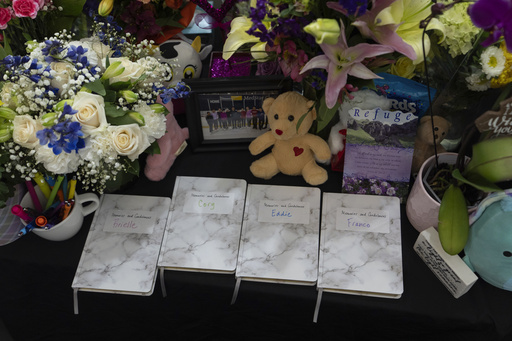
ARLINGTON, Va. — Families who lost loved ones in the worst aviation disaster in the United States in nearly a quarter of a century gathered at the crash site on Sunday, located near Washington, D.C. Dozens made their way along the shores of the Potomac River, adjacent to Reagan National Airport, where an American Airlines flight collided with an Army Black Hawk helicopter on Wednesday, resulting in the loss of all 67 individuals aboard both aircraft.
They were transported by buses, escorted by police, to honor the memory of their loved ones as federal officials endeavor to understand the circumstances surrounding the tragedy. Recovery teams were preparing to retrieve more debris from the frigid waters of the river.
On Sunday, Transportation Secretary Sean Duffy emphasized the importance of allowing federal aviation investigators the space they need to conduct their examination. However, he raised several questions about the crash during appearances on morning news shows.
“What was happening inside the towers? Were staff levels adequate? … What was the altitude of the Black Hawk, and were the pilots using night vision goggles?” Duffy questioned while being interviewed by CNN.
The American Airlines flight was in its descent to land from Wichita, Kansas, with 64 people on board. Meanwhile, the Army Black Hawk was engaged in a training exercise, carrying three soldiers when both aircraft tragically crashed into the Potomac.
Among those on the American Airlines flight were figure skaters returning from the U.S. Figure Skating Championships in Wichita, as well as a group of hunters returning from a guided excursion.
The Black Hawk helicopter was carrying Army Staff Sgt. Ryan Austin O’Hara, 28, from Lilburn, Georgia; Chief Warrant Officer 2 Andrew Loyd Eaves, 39, from Great Mills, Maryland; and Captain Rebecca M. Lobach from Durham, North Carolina, all of whom perished in the incident.
On Saturday, the National Transportation Safety Board (NTSB) shared that initial findings indicated inconsistencies in the reported altitudes of both the jet and the helicopter just before the crash. Investigators noted changes in the jet’s pitch approximately a second before impact but did not specify if that adjustment indicated an attempt to avert the disaster.
The jet’s altitude at the time of the collision was recorded at approximately 325 feet, while air traffic control had the Black Hawk at 200 feet, which is the highest permitted elevation for helicopters in that airspace. The reason for this variance remains unresolved.
Investigators are working to clarify the discrepancies, with additional data recovery from the helicopter’s black box being delayed due to water damage. They are also reviewing tower data, which may not always be accurate.
“That’s our task, to resolve these issues,” NTSB member Todd Inman stated. “This is a complex investigation with many components, and our team is dedicating significant effort to gathering the necessary information.”
Brice Banning, the lead investigator, mentioned that the cockpit voice recorder captured critical moments leading up to the collision.
“The crew’s last verbal reaction was recorded,” Banning said, adding that audio of the impact could be heard just one second later, following the end of the recording. Full investigations by the NTSB typically require at least a year to conclude, but officials aim to produce an initial report within 30 days.
Inman expressed compassion for the families affected by the tragedy, sharing that many are grappling with their grief. “Some were emotional, wanting to offer hugs; others were upset and frustrated. They are all in pain and desiring answers, and we aim to provide those answers,” Inman noted.
As of Saturday afternoon, recovery efforts had identified the remains of 42 victims, including 38 individuals. The expectation is that all remains will eventually be retrieved, with further recovery necessitating extraction of the aircraft’s fuselage from the river.
At one point, more than 300 responders were involved in the recovery operation, supported by two Navy salvage barges to assist with the heavy lifting.
On a separate note during a Fox News Sunday segment, Transportation Secretary Duffy mentioned that the Federal Aviation Administration (FAA) would be investigating staffing levels at the Reagan Airport control tower during the incident. Records revealed that five air traffic controllers were active at the time of the collision.
Typically, responsibilities for managing helicopter and airplane traffic are divided between two controllers; however, those roles were combined on that evening due to reduced traffic, which was classified as “unusual” in FAA reports.
“For many years, air traffic control staffing shortages have been a significant challenge,” Duffy stated, assuring that the Trump administration would prioritize improvements with qualified personnel managing airspace.
As the nation mourns this devastating event, an air ambulance crash occurred in Philadelphia on the same Friday, claiming the lives of all six aboard, including a child returning to Mexico after medical treatment, along with at least one individual on the ground.
On that same Friday, the FAA imposed strict limitations on helicopter operations around Reagan National Airport, following a statement from Trump suggesting that the Army helicopter had been operating at a higher altitude than permitted.
The recent crash marks the deadliest aviation incident in the United States since November 12, 2001, when a jetliner crashed in a residential area of Queens, New York, shortly after takeoff, resulting in 260 fatalities onboard as well as five casualties on the ground.
Despite such tragedies, experts consistently affirm the high safety standards associated with air travel. However, the congested airspace around Reagan National poses unique challenges, even for skilled pilots.

